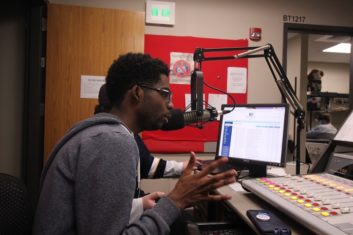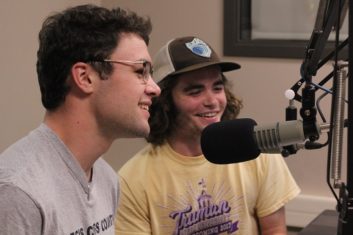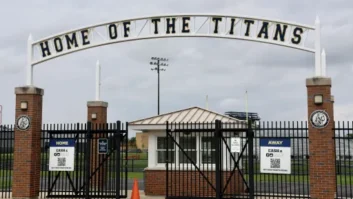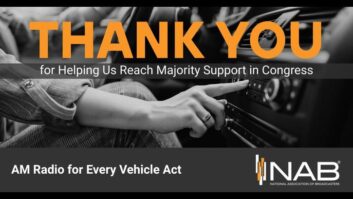Founded as a teachers’ college in the 1860s, Truman State University has evolved into “Missouri’s only public liberal arts and sciences institution.” And radio and media play a role in that mission.
Radio World contacted David C. Price, Ph.D., to learn more about the vibe around the station right now, part of our ongoing coverage of issues facing college and educational media.
Price is associate professor of communication and advisor to KTRM(FM), KKTR(FM) and TMN(TV).
Radio World: Describe the media programs and operations there.
David Price: The Department of Communication at Truman State University sponsors five media outlets, along with the digital/social media associated with these outlets: a campus newspaper, “The Index”; an online magazine, “Detours”; a television studio, TMN-TV; an NPR-affiliate station, KKTR 89.7 FM, which re-airs programming from KBIA out of the University of Missouri in Columbia; and a student- run radio station, KTRM 88.7 FM.
run radio station, KTRM 88.7 FM.
RW: Tell us more about that.
Price: KTRM is a student-run eclectic station. Students who want on-air experience are given one-hour shifts and are allowed to select their own formats.
We have approximately 75 to 100 students participating, with the vast majority doing on-air programs. In between shifts and when classes are not in session, the station airs adult CHR on the Simian automation platform from BSI.
The station describes itself as playing “genre spanning alternative and underrepresented music,” emphasizing independently produced music and music from smaller record labels.
KTRM is a Class A non-commercial station running 3,500 watts. KKTR is also a Class A noncommercial station running 3,500 watts.
KTRM has one air studio with a three-microphone set up for interviews, a back-up studio production room and two editing suites equipped with Adobe Audition and Adobe Premiere Pro.
The station is entirely student run, with a support staff of faculty advisors and an engineer; a secretary is available for purchasing and bookkeeping. Only the engineer, Norm White, works full-time supporting the radio and television outlets. The faculty advisor is given one quarter released teaching load and handles the required FCC documentation. (There are two faculty advisors at this time, one for radio and television, the other for newspaper and magazine.)
The mission of the station is educational — though we have to remind students of that frequently. There is some integration with the curriculum, but it is indirect so as to maintain the editorial and management independence of the media outlets.
[Read about the history of Truman State University.]
RW: Other media facilities on campus?
 Price: The campus public relations office has a videographer and photographer on staff and are actively producing print, social media and video productions. We do share some equipment with them when needed.
Price: The campus public relations office has a videographer and photographer on staff and are actively producing print, social media and video productions. We do share some equipment with them when needed.
The sports information area in the athletics department has video and audio production staff and equipment, though the live game productions are done by a contracted professional radio station.
The campus library has an audio/video production room for students who wish to self-produce content.
RW: How has the pandemic affected operations of the radio station?
Price: Our students were on spring break when we were told operations were to cease. The radio station has been playing Simian nonstop since then.
The faculty advisor kept the station running (since students were not allowed on campus) by adding an externally produced weekly public affairs program and monitoring the equipment.
When students return to campus, they will once again be responsible for the public affairs programming. Under the student station manager, some content has been created, emailed to the faculty advisor who then uploaded it to the log by the faculty advisor. Students have also updated the playlist, which was emailed to the faculty advisor, who then uploaded the new songs and added them to the log. The student station manager decided to feature only Black artists in June to support the Black Lives Matter messaging.
The student station manager and an assistant were permitted to enter the studio to create the new playlist and upload related content. That was the only time students were in the station from March 6 to the end of July.
[Related: “High School Station Stays on the Air, Minus Its Students”]
Students were allowed back into the studio beginning Aug. 3; the station manager and one staffer came in on Monday to being preparations for fall semester.
As of now, the student body is expected to return to campus Aug. 12, and the station is expecting to have student broadcasters on-air at that time to resume control of daily operations, including all the public affairs programming, content creation, uploading, modifying logs, and other management tasks.
During the last two months we have been actively discussing how to maintain a safe workspace when we have 75 to 100 students coming in and out the studio and changing personnel every hour. The student station manager has been involved in these discussions.
We struggle with developing cleaning protocols, especially with microphones and audio boards. We have requested, but not yet received, Plexiglas dividers to separate student work areas and alcohol-based cleaning supplies. We purchased microphone covers, though we are uncertain how effective they will be.
RW: For the educational year ahead, what are the priorities of the station or your broader programs?
Price: Our top priority has to be protecting the health of the students. We will repeatedly tell students that the concept of “the show must go on” is no longer true. We have the Simian backup so if a student doesn’t feel safe or doesn’t feel healthy they are not punished in any way for not being there for a show. This is true of all of our media outlets.
We are planning for students to return to the studio as in the past. However, our student station manager is encouraging and welcoming offsite productions, where students can prerecord segments or shows at home and submit them for loading into Simian. We hope this option decreases the number of bodies going in and out of the studio, but still keeps students involved.
RW: You mentioned the Simian system. Describe the rest of the air chain.
Price: The air studio has an Audioarts D75 digital audio console with Electro-Voice RE20 mics; a DaySequerra M2 HD Radio Modulation Monitor; Sage Digital Endec; Symetrix AirTools 6100 Broadcast Audio Delay; and Rane HC6S Headphone Console.
We also have three Denon DN-C635 Compact Disc/MP3 Players; a Technics SL-1200MK2 turntable; a JK Audio Broadcast Host Digital Hybrid; Samson Servo 200 Amplifier; Symetrix 581 Distribution Amplifier; and Dell Optiplex 7020 computer with two monitors. We expect students to supply their own headphones for health/sanitary reasons.
The backup/production studio has an Audioarts R55e On-Air Console with Electro-Voice RE20 mics and Dell Optiplex 7020 computer with two monitors. For field productions we’re using a Comrex Access IP codec.
The transmitter is on campus here in Kirksville, about a half-mile SSE from the studio. The STL microwave link is a Moseley SL9003Q. The RF chain at the transmitter site includes a Harris HD transmitter with an Orban audio processor; and the antenna is an ERI LPX-4E.
RW: How would you characterize the feelings of students these days about careers in radio and in media more broadly?
Price: Our campus is located in a relatively rural part of the state, and I see more interest in time-shifting audio (podcasting) than in live broadcast. We don’t have a commuting audience, for the most part, so dayparts are less significant.
In my teaching, I pitch the value of local content that print can’t and doesn’t do as well — particularly sports and weather broadcasting. We regularly broadcast Truman athletics (even though there is a professional station also broadcasting the games).
Our radio students are also big into community engagement, sponsoring live music performances on campus or in community venues, which draw large audiences.
RW: Anything else we should know?
Price: Although the pandemic has disrupted operations, the bigger threat to student media is the continuous budget cutting coming from legislators and the governor of the state. As they cut funds for higher education, the cuts are passed down to our operations also.
We fear that if a major piece of equipment were to fail we would not be able to find the money to replace it. Some of our technology is aging, and our engineer has done his best to keep it going, but there are weak links in the production chains that could be big-budget problems.







